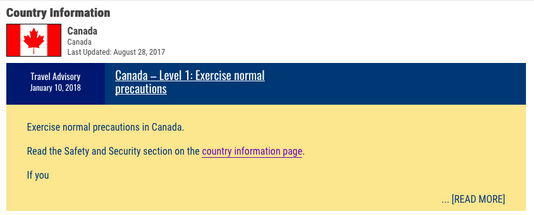The U.S. Department of State recently announced a new risk factor intended for the information and safety of U.S. citizens who plan to travel (or are traveling) internationally. The new indicator makes travelers aware of the risk of kidnapping and Mexico, Haiti and the Philippines are included in what is currently a list of 35 countries that have a high risk for U.S. citizens to be abducted.
The Department of State last updated its system of travel advisories in early 2018, when it revamped how it communicated the level of safety for U.S. citizens when traveling to foreign countries. Using a rating of 1 through 4, with 4 designating the most dangerous, it was considered to be, “clear, timely and reliable safety and security information worldwide.”
Along with the 1 through 4 rating, each country began having lettered indicators with clear reasons about why a certain level had been assigned:
- C – Crime: Widespread violent or organized crime is present in areas of the country. Local law enforcement may have limited ability to respond to serious crimes.
- T – Terrorism: Terrorist attacks have occurred and/or specific threats against civilians, groups, or other targets may exist.
- U – Civil Unrest: Political, economic, religious, and/or ethnic instability exists and may cause violence, major disruptions, and/or safety risks.
- H – Health: Health risks, including current disease outbreaks or a crisis that disrupts a country’s medical infrastructure, are present. The issuance of a Centers for Disease Control Travel Notice may be a factor.
- N – Natural Disaster: A natural disaster, or its aftermath, poses danger.
- E – Time-limited Event: A short-term event, such as an election, sporting event, or other incidents that may pose a safety risk.
- O – Other: There are potential risks not covered by previous risk indicators. Read the country’s Travel Advisory for details.
So, for example:




In this newest update, they have now added a “K” indicator to let U.S. travelers know that they could be at risk of being kidnapped or taken hostage if they travel to the countries with this indicator.
So for example:




As per the Dep’t of State, “”The new ‘K’ indicator is part of our ongoing commitment to provide clear and comprehensive travel safety information to US citizens so they can make informed travel decisions.”
The following countries have been updated to include the new “K” indicator:
Afghanistan, Algeria, Angola, Bangladesh, Burkina Faso, Cameroon, Central African Republic, Colombia, Democratic Republic of the Congo, Ethiopia, Haiti, Iran, Iraq, Kenya, Lebanon, Libya, Malaysia, Mali, Mexico, Niger, Nigeria, Pakistan, Papua New Guinea, Philippines, Russian Federation, Somalia, South Sudan, Sudan, Syria, Trinidad and Tobago, Turkey, Uganda, Ukraine (in Russian-controlled eastern Ukraine), Venezuela, and Yemen.
You can see all Travel Advisories, most recent Alerts issued for each country, and an interactive map in mobile-friendly formats, on this page.
Stay safe, travel friends!
Like this post? Please share it! We have plenty more just like it and would love if you decided to hang around and clicked the button on the top (if you’re on your computer) or the bottom (if you’re on your phone/tablet) of this page to follow our blog and get emailed notifications of when we post (it’s usually just two or three times a day). Or maybe you’d like to join our Facebook group, where we talk and ask questions about travel (including Disney parks), creative ways to earn frequent flyer miles and hotel points, how to save money on or for your trips, get access to travel articles you may not see otherwise, etc. Whether you’ve read our posts before or this is the first time you’re stopping by, we’re really glad you’re here and hope you come back to visit again!
This post first appeared on Your Mileage May Vary
